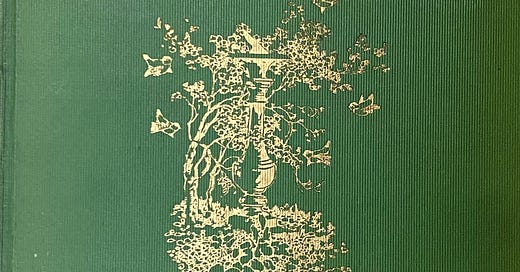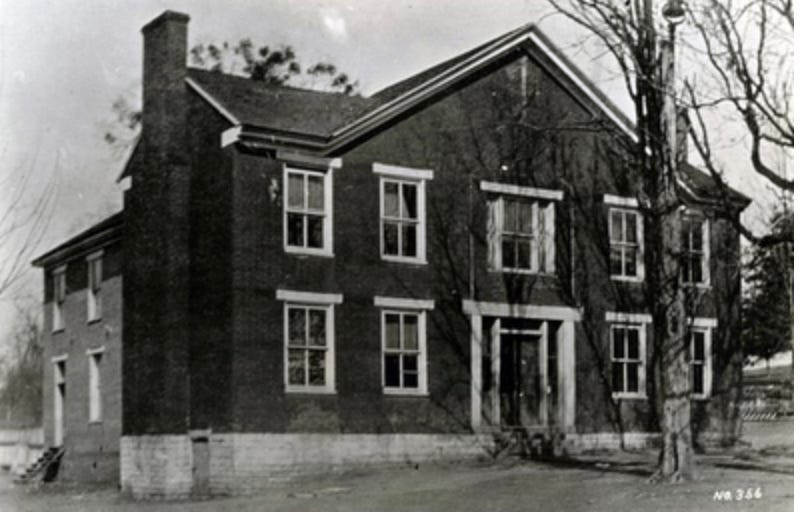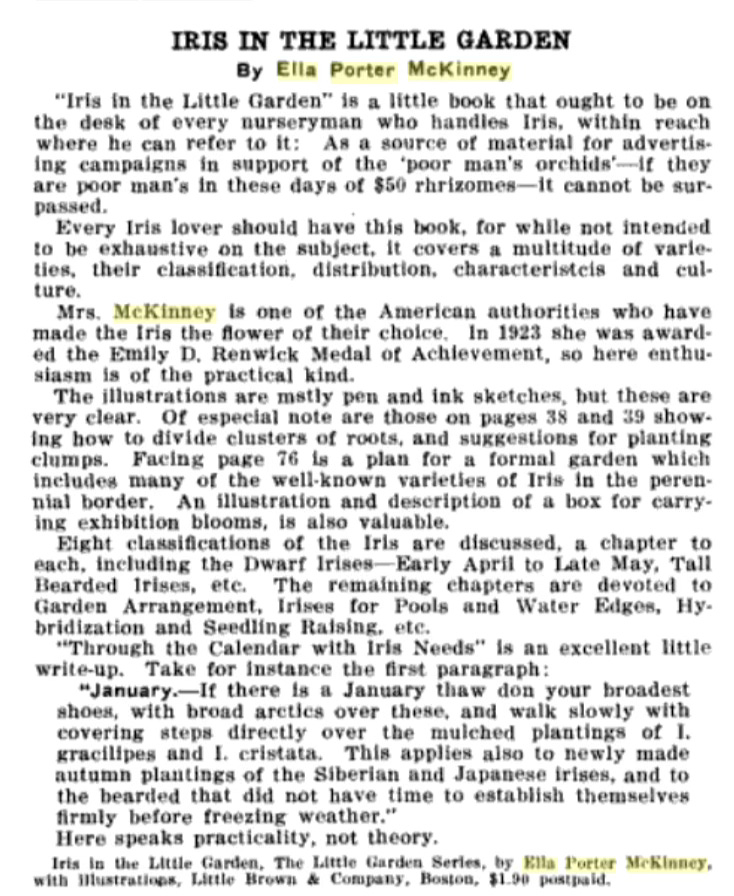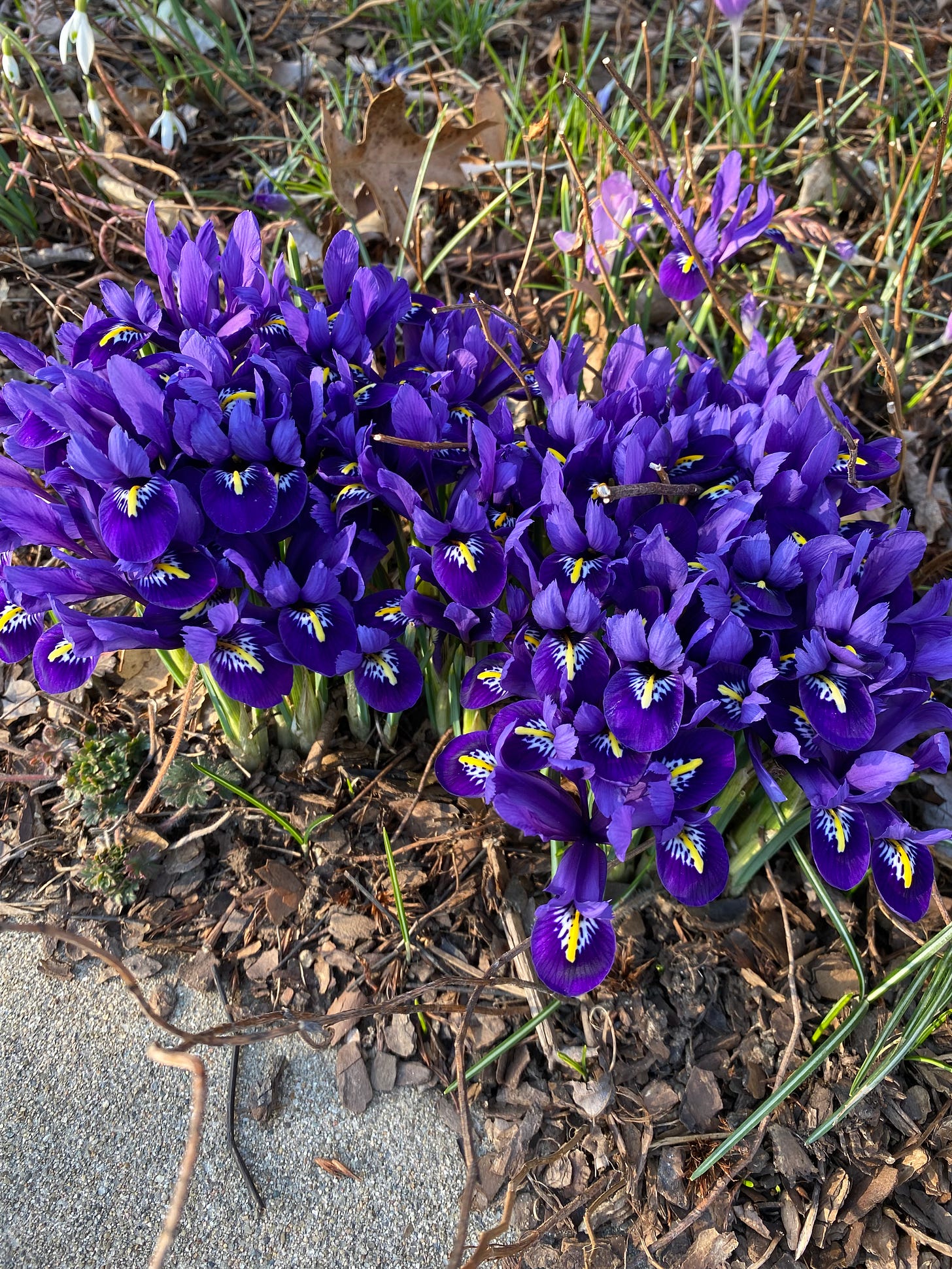It’s time to go back to The Little Garden series of books, edited by Mrs. Francis King, and discover another lost lady of garden writing, Ella Porter McKinney, who wrote Iris in the Little Garden (1927).
Initially, I didn’t find much information about Ella in the online resources I usually check, but every time I was about to give up and go ahead with what little I found, a new search would bring up some new information.
Ella’s Biography
Ella Porter McKinney was born in 1868 to Thomas and Susan Porter in Kentucky. (I never found her actual birthdate.)
She graduated from the Glasgow Normal School in July 1886. According to the article about the commencement exercises, she gave a speech about “The W.C.T.U” as part of the exercises. I’m guessing that W.C.T.U. was the Women’s Christian Temperance Union. It seems every student spoke about something during the commencement exercises, which lasted two days.
I took a brief detour to learn more about Normal Schools, which were established to address a shortage of teachers qualified to be grammar or common school teachers. The Glasgow Normal School was in Glasgow, Kentucky, but moved to Bowling Green at some point and eventually became Western Kentucky University.
In 1890, Ella married Dr. Colin Shepard McKinney. They lived initially in Nashville, Tennessee, then shortly after, moved to Madison, New Jersey.
Dr. McKinney was 19 years older than Ella and had a least two sons from a previous marriage to Ada Pierson. He died in 1930. Ella died on January 31, 1944, aged 75, and was buried in Tennessee, where at least one of her stepsons lived at the time, Colin P. McKinney, a lawyer who served as a judge on the Tennessee State Supreme Court. (He was just five years older than Ella and also died in 1944.)
Like other writers in The Little Garden series of books from the 1920s, Ella was involved in a local garden club—hers was in Madison, New Jersey—and the National Garden Club of America.
While looking for a picture of Ella, I found an interesting item in the Virginia Gazette in 1908:
I don’t think she found that farm in Virginia that she was looking for because she was living in New Jersey when she died.
A Scholarship Named For Her Parents
I spent quite a bit of time trying to find Ella’s actual birth date and a picture of her, and though I never found either one, I did discover that she made provisions in her will to establish a memorial scholarship fund at Western Kentucky College, now University, to be called “Tom and Susan McReynolds Porter Memorial Scholarship” to be used “exclusively for worthy students of Butler County.” The scholarship was actually set up in 1955, following the death of Ella’s sister, with a memorial contribution of $25,000. In today’s dollars, that’s almost $290,000.
I checked Western Kentucky’s website and that scholarship fund, named for her parents, is still listed.
Her Books
I originally thought Ella wrote only one book, Iris in the Little Garden, but my searches brought up another book, Gardens of New Jersey, written in 1932. There are also several articles written by Ella, virtually all of them about irises, which were obviously her overriding passion in the garden.
Her book received high praise when published.
Irises
It’s clear from her book that Ella’s passion was irises, and not just the bearded irises that most people think of when someone mentions irises, but all the other types, including Iris reticulata, which have just finished blooming in my garden.
She not only grew irises but also hybridized them.
From The Garden Magazine, June 1921, I found this reference to her iris breeding.
“Few of the other breeders of whom I wish to speak have sent varieties into commerce. Mrs. C. S. McKinney of Madison has one of the most beautiful if not the most beautiful iris gardens I have ever visited. It is exceedingly simple— pallida dalmatica predominates interspersed with varieties such as Mme. Chereau, Mrs. H Darwin, and Aurea. Among Mrs. McKinney’s many fine seedlings are Piquante, Simplicity, and Her Rival.”
While I was searching for more information about Ella, I also ended up in a book of Elizabeth Lawrence’s writing, A Garden of One’s Own, edited by Barbara Scott and Bobby J. Ward. Elizabeth Lawrence is a relatively well-known southern garden writer who lived and gardened in Charlotte, North Carolina. (I think she’s relatively well-known, but since so many haven’t heard of, she’s on my list for a future article.)
Elizabeth wrote in an article titled “Brothers of the Spade” about how many plants are only available when handed from one garden to another—plants such as Iris persica.
“The next record I have is in Ella Porter McKinney’s Iris for the Little Garden. Her bulbs came to her, she says, from an old garden in Tennessee, where they had been know “since the memory of man,” and had made large clumps, and had gone even further afield than Mrs. McKinney’s garden in northern New Jersey. From this same stock came the bulbs that Vivian Grapes grows in Big Spring, Nebraska. “I’m sorry you lost Iris persica,” Miss Grapes wrote. “It bloomed beautifully in my garden this spring. I am sure it is true, for it came from the very place you mentioned, the old garden in Tennessee. It blooms just above the ground with foliage like young corn, and blue-green falls tipped with blue-black velvet.” The pretty sweet-scented flowers were once found in old gardens in North Carolina, but Miss Grapes is the only person I know of who grows them now; and it is some time since I have found them in the trade.”
I suspect that many of the irises Ella wrote about nearly 100 years ago are no longer “available in the trade.” But that shouldn’t prevent us from reading these old books, to look for nuggets of wisdom and interesting tidbits, to be reminded of how deep one can go in a garden when focused on one genus.
For example, in the chapter “Long Human Associations and Adaptability of the Iris,” Ella wrote,
Attempts to trace the history of the iris impress the close human association the plant has ever held. Pliny, who entertained high opinion of the medicinal value of scents, declared that as many as forty-two ailments were curable by the scent of the iris. Dioscorides wrote, “Irises are very useful generally,” which opinion he emphasized by relying with equal assurance upon the dried rhizomes to bring babes safely into the world and to remove freckles from their faces when grown up! “
The entire book can be read online, and good used copies are still out there!
Questions
As always, the more we learn the more questions we have.
What did Ella do in the four years between finishing school and marrying Dr. McKinney? One might presume she taught school, but there is no record of that online that I could find. And what kind of doctor was he? Why did they move to New Jersey?
Is there a picture anywhere of Ella? I went so far as to search for pictures of students at the Glasgow Normal School to see if she was in a group photo, but I couldn’t find one.
There are probably more questions that are unanswerable with the resources I have, but at least we know a little bit more about Ella now than when we started.
If you know of a lost lady of garden writing that I should add to my list, let me know via a comment or email me!










Another great post!